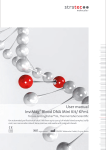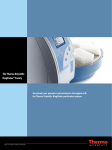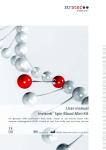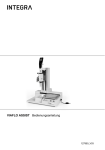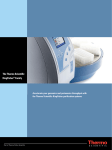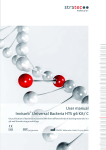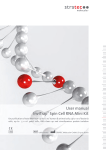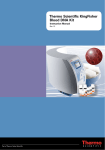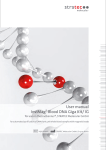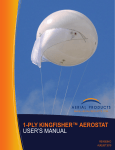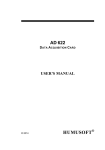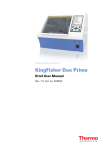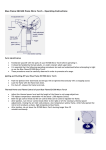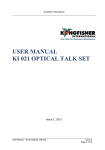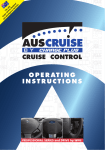Download InviMag Forensic Kit / KingFisher mL
Transcript
InviMag® Forensic Kit / KingFisher mL for extractions of genomic DNA from forensic samples using KingFisher mL instrument (Thermo Electron) Vers.1205 Kit components (storage at room temperature) Important: Store the MAP Solution A at 4 °C Store lyophilized Proteinase K at 2 - 8 °C ; Store diluted Proteinase K at 20 °C, but repeated freezing and thawing will reduced the activity dramatically. Dividing the Proteinase K into aliquots and storage at 20°C is recommended. 15 extractions 75 extractions 1 x 10 ml 1 x 50 ml 10 mg for 0.5 ml working solution 5 x 10 mg for 5 x 0.5 ml working solution MAP Solution A 1 x 0.5 ml 2 x 1 ml Binding Buffer T 1 x 8 ml 1 x 30 ml Lysis Buffer G Proteinase K 1 x 2 ml 1 x 15 ml 1 x 18 ml (final volume 60 ml) 1 x 45 ml (final volume 150 ml) Receiver Tubes Tubes ( 1.5 ml ) 1 x 15 5 x 15 KingFisher ml Tip Combs (Thermo Electron) 1x3 1 x 15 KingFisher ml Tube Strips (Thermo Electron) 1 x 15 5 x 15 1 1 Elution Buffer D Wash Buffer Manual Initial steps Add 42 ml of 96 % - 100 % ethanol to the bottle Wash Buffer, mix thoroughly and keep the bottle always firmly closed ! Dilute Proteinase K by addition of 0.5 ml of ddH2O, mix thoroughly and store like described below ! 1 Add 105 ml of 96 % - 100 % ethanol to the bottle Wash Buffer , mix thoroughly and keep the bottle always firmly closed ! Dilute Proteinase K by addition of 0.5 ml of ddH2O, mix thoroughly and store like described below ! Vers.1205 KingFisher software 2.6.2 KingFisher Software 2.6.2 is used to create protocols for the KingFisher, KingFisher mL and KingFisher 96 instruments. Once a protocol has been created, the user can either transfer the protocol into the KingFisher instrument memory or run the protocol directly from the software. Directly run protocols are not stored in the instrument memory. Checking the PC requirements The table below lists the PC requirements for KingFisher Software 2.6.2 PC requirements Interface Serial communication port via an RS-232 full duplex interface Supported operating systems Microsoft Windows 2000 Microsoft Windows XP Professional Disk space 500 MB free disk space Processor Memory Intel Pentium ≥ 700 MHz recommended 220 MB RAM recommended Serial ports available Pointing device 1 Mouse or equivalent is necessary 1 SVGA monitor with at least 1024 x 768 resolution and at least a 16-bit color environment Service Packs installed Microsoft Windows 2000: Service Pack 4 (or greater) Microsoft Windows XP Professional: Service Pack 2 (or greater) CD-ROM drive Monitor / color settings Browser Microsoft Internet Explorer 6.0 (or greater) installed If you do not have the correct Service Packs installed, you can download them from the Microsoft web pages: http://www.microsoft.com. 2 Vers.1205 Protocols: Isolation of DNA from forensic samples 1. Sample Lysis A: Isolation of DNA from Buccal Swabs Transfer 600 µl of Lysis Buffer G and 25 µl of Proteinase K into a 1.5 ml Reaction Tube. Transfer the swab into the so prepared tube, vortex the tube for 5 s and incubate the sample at 56°C for 20 minutes under continuously shaking (e.g. by using a thermomixer). Important Note: To get maximum yield of DNA it is essential to leave the swab during the complete lysis time into the reaction tube. It is possible to cut the shaft of the swab, so that you can close the cap of the reaction tube. It is also possible to do the lysis step with opened cap. The removing of the swab from the reaction tube ahead of time will result in a dramatically reduced final yield ! After lysis time carefully squeeze out the swab on the wall of the tube and discard the swab. Transfer the lysed sample into the Tube A of the KingFisher tube strip and add 300 µl of Binding Buffer T and 20 µl MAP Solution A (see also below). (Vortex the tube MAP Solution A vigorously before use ! ). B: Isolation of DNA from blood stains, saliva stains etc. Cut the material containing the stains into small pieces and transfer it into a 1.5 ml Reaction Tube. Add 600 µl of Lysis Buffer G and 25 µl of Proteinase K. For semen stains at aditional 30 µl 1 M DTT ( not provided) to the Lysis Buffer and Proteinase K mix. Vortex the tube for 5 s. Incubate the sample at 56°C for at least 1 h under continuously shaking (e.g. by using a thermomixer). Incubation overnight is also possible. We recommend the overnight lysis at 42°C under continously shaking. After lysis time carefully transfer the lysed sample into the Tube A of the KingFisher tube strip (avoid carry over of starting material; optional spin down the starting material) Add the 300 µl of Binding Buffer T and 20 µl MAP Solution A (see also below). (Vortex the tube MAP Solution A vigorously before use ! ). C: Isolation of DNA from hair roots Place a single hair root (or more) into a 1.5 ml Reaction Tube. Add 600 µl of Lysis Buffer G and 25 µl of Proteinase K and 30µl 1 M DTT (not provided). Vortex the tube for 5 s. Incubate the sample at 56°C for at least 1 h under continuously shaking (e.g. by using a thermomixer). Incubation overnight is also possible. We recommend the overnight lysis at 42°C under continously shaking. After lysis time carefully transfer the lysed sample into the Tube A of the KingFisher tube strip (avoid carry over of starting material; optional spin down the starting material) Add the 300 µl of Binding Buffer T and 20 µl MAP Solution A (see also below). (Vortex the tube MAP Solution A vigorously before use ! ). 3 Vers.1205 D: Isolation of DNA from cigarette butts Remove of a small piece (3 - 5 mm) of the brown filter paper or of a part of the filter and place the material in a 1.5 ml Reaction Tube. Add 600 µl of Lysis Buffer G and 25 µl of Proteinase K. Vortex the tube for 5 s. Incubate the sample at 56°C for at least 1 h under continuously shaking (e.g. by using a thermomixer). Incubation overnight is also possible. We recommend the overnight lysis at 42°C under continously shaking. After lysis time carefully transfer the lysed sample into the Tube A of the KingFisher tube strip (avoid carry over of starting material; optional spin down the starting material) Add the 300 µl of Binding Buffer T and 20 µl MAP Solution A (see also below). (Vortex the tube MAP Solution A vigorously before use ! ). E: Isolation of DNA from bubble gum Cut a part of the bubble gum into small pieces and place the material into a 1.5 Reaction Tube. Add 600 µl of Lysis Buffer G and 25 µl of Proteinase K. Vortex the tube for 5 s.Incubate the sample at 56°C for at least 3 h under continuously shaking (e.g. by using a thermomixer). Incubation overnight is also possible. We recommend the overnight lysis at 42°C under continously shaking. After lysis time carefully transfer the lysed sample into the Tube A of the KingFisher tube strip (avoid carry over of starting material; optional spin down the starting material) Add the 300 µl of Binding Buffer T and 20 µl MAP Solution A (see also below). (Vortex the tube MAP Solution A vigorously before use ! ). F: Isolation of DNA from stamps and envelopes Cut the material into small pieces and transfer it into a 1.5 ml Reaction Tube. Add 600 µl of Lysis Buffer G and 25 µl of Proteinase K. Vortex the tube for 5 s. Incubate the sample at 56°C for at least 1 h under continuously shaking (e.g. by using a thermomixer). Incubation overnight is also possible. We recommend the overnight lysis at 42°C under continously shaking. After lysis time carefully transfer the lysed sample into the Tube A of the KingFisher tube strip (avoid carry over of starting material; optional spin down the starting material) Add the 300 µl of Binding Buffer T and 20 µl MAP Solution A (see also below). (Vortex the tube MAP Solution A vigorously before use ! ). 4 Vers.1205 G: Isolation of DNA from tissue samples Place approximately 0.5 20 mg of fresh or frozen tissue sample (cut the material into small pieces ) into a 1.5 ml Reaction Tube tube. Add 600 µl of Lysis Buffer G and 25 µl of Proteinase K. Vortex the tube for 5 s. Incubate the sample at 56°C for at least 1 h under continuously shaking (e.g. by using a thermomixer). Incubation overnight is also possible. We recommend the overnight lysis at 42°C under continously shaking. After lysis time carefully transfer the lysed sample into the Tube A of the KingFisher tube strip (avoid carry over of starting material; optional spin down the starting material) Add the 300 µl of Binding Buffer T and 20 µl MAP Solution A (see also below). (Vortex the tube MAP Solution A vigorously before use ! ). H: Isolation of DNA from nail clippings Place the nail clippings into a 1.5 ml Reaction Tube. Add 600 µl of Lysis Buffer G and 25 µl of Proteinase K and 30 µl 1 M DTT (not provided). Vortex the tube for 5 s. Incubate the sample at 56°C for at least 1 h under continuously shaking (e.g. by using a thermomixer). Incubation overnight is also possible. We recommend the overnight lysis at 42°C under continously shaking. After lysis time carefully transfer the lysed sample into the Tube A of the KingFisher tube strip (avoid carry over of starting material; optional spin down the starting material) Add the 300 µl of Binding Buffer T and 20 µl MAP Solution A (see also below). (Vortex the tube MAP Solution A vigorously before use ! ). Important Notes: 1. Using the kit for other kinds of forensic sample, the selection of one of the described protocols is recommended. 2. After lysis, the automatic extraction on the KingFisher ml, is identically for all types of starting materials. So it is possible to extract the DNA from different sample types simultaneously. 3. Optional, for isolation of DNA from forensic samples containing extrem low amounts of DNA it could be helpful to add Carrier RNA to the Binding Step (after lysis ). We recommend to use Carrier RNA (e.g. Poly(A) RNA; Roche Diagnostics; No.108626). Dissolve the RNA in RNase free water to obtain a solution of 1 µg/µl. Divide aliquots and store at 20°C. Do not freeze and thaw the aliquots for more than 3 times. We recommend adding of 1 µl Carrier RNA per sample. 5 Vers.1205 2. KingFisher mL process Important: Before starting the purification process with the KingFisher mL please read carefully the KingFisher mL user manual! After finishing the sample lysis fill the tubes of the KingFisher mL strip tubes with the following Buffers respectively. Please avoid evaporation of the prefilled buffer components by sealing the KingFisher tube strips with a sealing foil or with parafilm! A. Place an appropriate number of tube strips needed for the samples (one tube strip per sample) into removable tube strip tray. Note! Resuspend the magnetic particles (MAP solution A) thoroughly before use! B. Tube A: Add 625 µl lysed sample, 300 µl Binding buffer T and 20 µl MAP solution A C. Tube B: Add 800 µl Wash buffer D. Tube C: Add 800 µl Wash buffer E. Tube D: Add 120 µl Elution Buffer D F. Insert the tubestrip tray to the instrument and insert the tip combs into the slots. G. Close the front lid and start the process by selecting protocol InviMAG_Forensic_mL using arrow keys and press START. H. Remove the tubestrip tray from the KingFisher mL after the program has completed. Important Notes : 1. After finishing the extraction protocol, the Tube E contains the extracted DNA. Store the DNA under adequate conditions. We recommend to transfer the extracted DNA into the 1.5 ml Receiver Tubes for further storage and freeze the DNA at 20°C. 2. If the DNA contains carryover of magnetic particle, transfer the DNA into a 1.5 ml reaction tube and centrifuge at maximum speed for 1 minute and pipet the DNA into a new tube. 6 Vers.1205 InviMAG_Forensic_mL protocol description 1. Sample lysate is incubated with magnetic particles for 3 minutes in tube A. 2. Particles are washed with Wash Buffer for 50 sec in tube B. 3. Particles are washed with Wash Buffer for 50 sec in tube C. 4. A drying step (8 min) is performed after washing step in tube C. 5. DNA is released into Elution Buffer D in tube D. 6. Particles are discarded into tube C. Ordering Information (KingFisher mL and consumables) Cat.no Description 5400050 97002111 97002121 97002131 97002141 KingFisher mL, Magnetic Particle Processor, 100-240 V, 50/60 Hz KingFisher mL tip comb, 800 pcs KingFisher mL tube, 900 pcs (20x45 pcs) KingFisher mL Combi 60 (tubes and tip combs for 60 samples) KingFisher mL Combi 240 (tubes and tip combs for 240 samples) 7 Vers.1205








